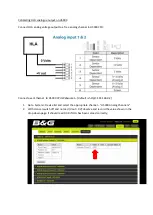
M.4
®
s
Dear Patient,
Your doctor has prescribed the functional knee
brace M.4
®
s for you. Please read through these
instructions carefully to help ensure that your
brace is fitted correctly.
Indications
ruptures of cruciate ligaments with
•
accompanying injuries.
isolated ruptures of the anterior cruciate
•
ligament.
ruptures and/or instability of the collateral
•
ligaments.
after reconstruction of cruciate ligaments.
•
for conservative treatment of knee joint
•
instability.
Side-Effects / Contraindications
none are currently known.
Setting the flexion / extension limits
extension limit wedge, silver:
0°, 10°, 20°, 30°, 45°
flexion limit wedge, black:
0°, 10°, 20°, 30°, 45°, 60°, 75°, 90°, 120°
can be immobilized at: 0°, 10°, 20°, 30°, 45°
for immobilizing the orthosis, first insert the
flexion wedge and then the corresponding
extension wedge. the medial (inside) and the
lateral (outside) wedge settings must always be
the same.
10
1.
° extension and 90° flexion wedges are
pre-installed in your knee brace.
t
2. o change the wedges, simply remove the
joint cover.
r
3. eplacement extension wedges (silver) can
be found in the wedge set marked ‘r-e’ and
‘L-e’. slide the new wedge into the joint from
the front, and secure it by tightening the
screws. insert the wedge so that the letter
shown on the joint plate points upwards
(r or L). now insert the screw and tighten.
t
4. o replace the black flexion wedge, loosen
the screw and pull the wedge out from the
back of the orthosis. select the desired wedge
from the set marked ‘r-f’ and ‘L-f’.
insert the wedge so that the letter shown on
the joint plate points upwards (r or L). now
insert the screw and tighten.
B
5. end and flex the brace ‘joint’ a couple of
times and check that the wedges are positioned
correctly. finally, secure the joint cover.
Important notes
changes to the extension and flexion limits
should only be made with instructions from
your doctor or orthotist. in order to prevent
hyperextension, always insert extension wedges
or 0° wedges. the wedges define the exact
excursion of the orthosis. in difficult soft-tissue
conditions, e.g. where the soft-tissues are under
compression, it may be necessary to insert the
larger wedge to limit the joint movement to the
desired excursion. in addition, make sure that
the orthosis joints are correctly positioned: the
middle of the joints should be level with the
upper border of the patella. the joint must lie
behind the midline of the leg.
Shaping the orthosis
When shaping the orthosis, please ensure that
the joints stay parallel. this guarantees that the
orthosis will function well and run easily and
that there is no excessive wear.
Fastening the belt eyes
the belt eyes have been adequately fastened
and are, to some extent, deliberately mobile.
please do not tighten the screws. if too much
force is applied, the screws may break.
Fitting instructions
open all the straps. sit on the edge of a chair,
•
pull the brace up the affected leg and flex your
knee to 45°. position the joints so that the
center of the hinges (extension wedges) are
level with the top edge of the kneecap. Make
sure that the brace is not twisted on your leg.
first, fasten the lower front calf strap (strap
•
#1), then the upper back thigh strap (#2).
Keep your knee in a flexed position and push
both joints towards the back of the leg.
now fasten the lower back thigh strap (#
•
3).
Make sure that the hinge joints are not
positioned in front of the midline of the leg.
now fasten the upper front calf strap (#
•
4).
then the upper back calf strap (#5), and finally
the front thigh strap (#6).
Bend your knee slightly a few times and refasten
•
the straps again in the order described above to
prevent the brace slipping.
english
Содержание M.4 s OA
Страница 1: ...M 4 s knee brace instructions for use instrucciones para uso...
Страница 2: ...1 2 3 4 5 6 7 8 9...
Страница 7: ......


























